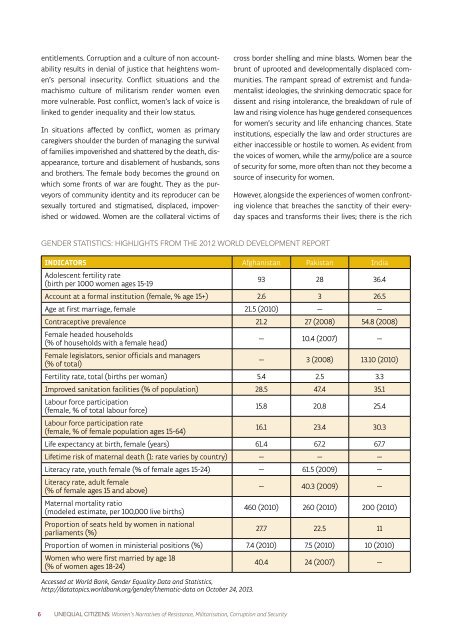CC_India
CC_India
CC_India
Create successful ePaper yourself
Turn your PDF publications into a flip-book with our unique Google optimized e-Paper software.
entitlements. Corruption and a culture of non accountability<br />
results in denial of justice that heightens women’s<br />
personal insecurity. Conflict situations and the<br />
machismo culture of militarism render women even<br />
more vulnerable. Post conflict, women’s lack of voice is<br />
linked to gender inequality and their low status.<br />
In situations affected by conflict, women as primary<br />
caregivers shoulder the burden of managing the survival<br />
of families impoverished and shattered by the death, disappearance,<br />
torture and disablement of husbands, sons<br />
and brothers. The female body becomes the ground on<br />
which some fronts of war are fought. They as the purveyors<br />
of community identity and its reproducer can be<br />
sexually tortured and stigmatised, displaced, impoverished<br />
or widowed. Women are the collateral victims of<br />
cross border shelling and mine blasts. Women bear the<br />
brunt of uprooted and developmentally displaced communities.<br />
The rampant spread of extremist and fundamentalist<br />
ideologies, the shrinking democratic space for<br />
dissent and rising intolerance, the breakdown of rule of<br />
law and rising violence has huge gendered consequences<br />
for women’s security and life enhancing chances. State<br />
institutions, especially the law and order structures are<br />
either inaccessible or hostile to women. As evident from<br />
the voices of women, while the army/police are a source<br />
of security for some, more often than not they become a<br />
source of insecurity for women.<br />
However, alongside the experiences of women confronting<br />
violence that breaches the sanctity of their everyday<br />
spaces and transforms their lives; there is the rich<br />
GENDER STATISTICS: HIGHLIGHTS FROM THE 2012 WORLD DEVELOPMENT REPORT<br />
INDICATORS Afghanistan Pakistan <strong>India</strong><br />
Adolescent fertility rate<br />
(birth per 1000 women ages 15-19<br />
93 28 36.4<br />
Account at a formal institution (female, % age 15+) 2.6 3 26.5<br />
Age at first marriage, female 21.5 (2010) — —<br />
Contraceptive prevalence 21.2 27 (2008) 54.8 (2008)<br />
Female headed households<br />
(% of households with a female head)<br />
— 10.4 (2007) —<br />
Female legislators, senior officials and managers<br />
(% of total)<br />
— 3 (2008) 13.10 (2010)<br />
Fertility rate, total (births per woman) 5.4 2.5 3.3<br />
Improved sanitation facilities (% of population) 28.5 47.4 35.1<br />
Labour force participation<br />
(female, % of total labour force)<br />
15.8 20.8 25.4<br />
Labour force participation rate<br />
(female, % of female population ages 15-64)<br />
16.1 23.4 30.3<br />
Life expectancy at birth, female (years) 61.4 67.2 67.7<br />
Lifetime risk of maternal death (1: rate varies by country) — — —<br />
Literacy rate, youth female (% of female ages 15-24) — 61.5 (2009) —<br />
Literacy rate, adult female<br />
(% of female ages 15 and above)<br />
— 40.3 (2009) —<br />
Maternal mortality ratio<br />
(modeled estimate, per 100,000 live births)<br />
460 (2010) 260 (2010) 200 (2010)<br />
Proportion of seats held by women in national<br />
parliaments (%)<br />
27.7 22.5 11<br />
Proportion of women in ministerial positions (%) 7.4 (2010) 7.5 (2010) 10 (2010)<br />
Women who were first married by age 18<br />
(% of women ages 18-24)<br />
40.4 24 (2007) —<br />
Accessed at World Bank, Gender Equality Data and Statistics,<br />
http://datatopics.worldbank.org/gender/thematic-data on October 24, 2013.<br />
6 UNEQUAL CITIZENS: Women’s Narratives of Resistance, Militarisation, Corruption and Security


